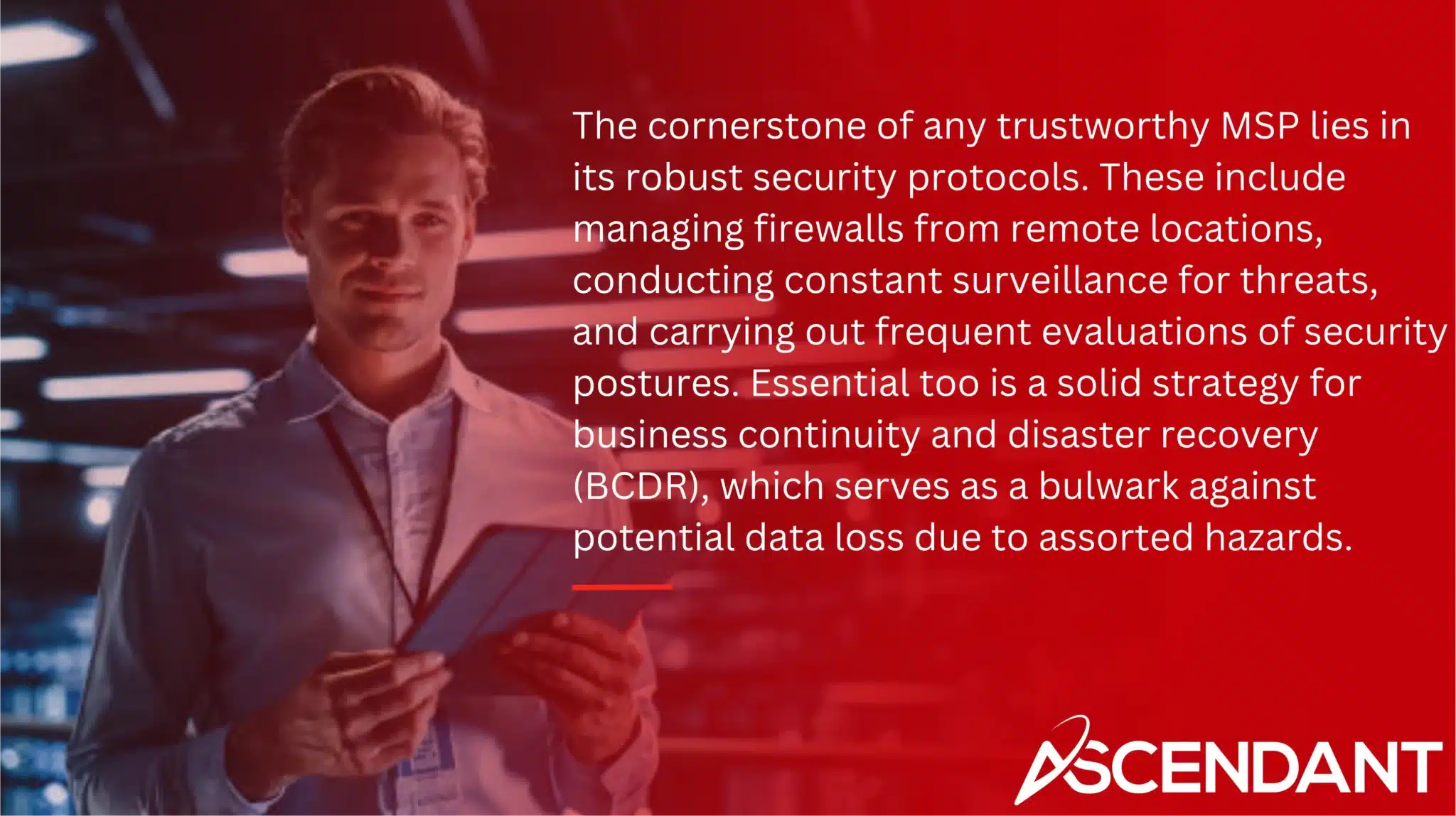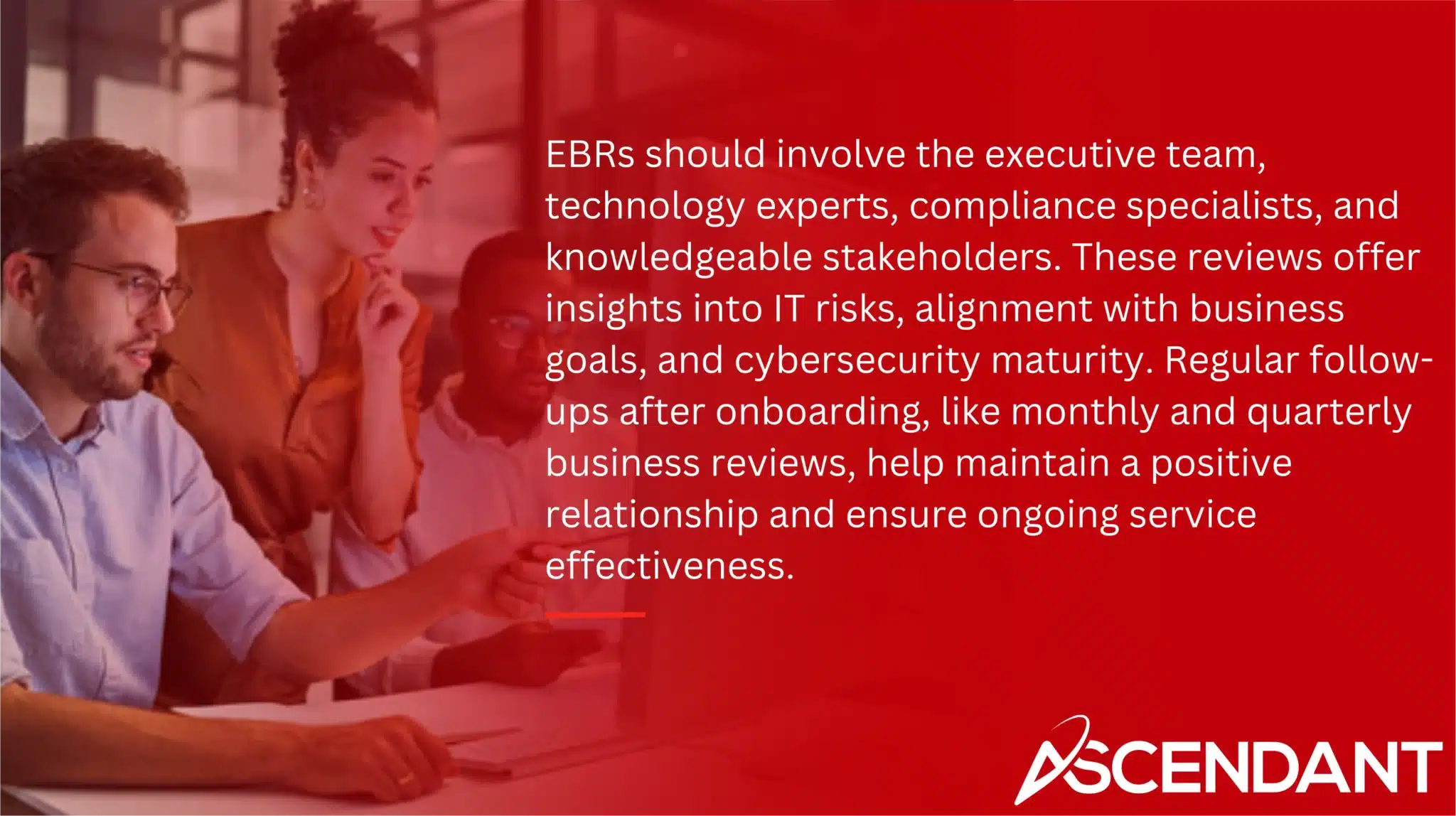Before hiring a managed IT provider, it’s essential to ask the right questions. This helps you choose a provider that meets your needs and avoids costly mistakes. Here are the top questions to ask before hiring a managed IT provider to ensure you make the best possible decision.
In This Article:
- What Is Your Experience with Our Industry?
- How Do You Ensure Data Security and Compliance?
- What Service Level Agreements (SLAs) Do You Offer?
- Do You Provide 24/7 Support?
- Are Your Services Proactive or Reactive?
- What Is Your Pricing Model?
- How Will We Collaborate and Communicate?
- What Onboarding Process Do You Follow?
- Can You Provide References from Similar Organizations?
- What Happens If We Need to Terminate the Relationship?
Key Takeaways
- Evaluate the MSP’s industry-specific expertise to ensure tailored support and compliance with regulatory standards.
- Assess the MSP’s data security measures and service level agreements (SLAs) to confirm their commitment to service quality and effective problem resolution.
- Understand the MSP’s onboarding process and termination terms to facilitate a seamless transition and protect your business interests.
What Is Your Experience with Our Industry?
Choosing a managed service provider (MSP) with industry-specific expertise is essential among the pool of providers and professionals. This expertise enables them to comprehend the distinct challenges and regulatory mandates specific to your sector. For example, an MSP versed in healthcare will be knowledgeable about HIPAA regulations, while one focused on financial services will be adept at navigating financial compliance laws. Engaging a dependable service provider can notably increase operational efficiency for your business.
An MSP that has experience working with organizations within your industry can more efficiently address its intricate demands. They are likely not only to offer standard solutions but also tailor their services according to what suits you best. When evaluating potential MSPs, inquire about their history of collaboration with similar entities in your field. This helps assess how well they understand both the requirements and standards pertinent to managing your business needs.
Each industry possesses unique necessities. As such, industries like legal depend on secure document management systems along with e-discovery capabilities, whereas retail companies prioritize solid e-commerce infrastructures alongside safeguarding customer information. Recognizing these distinctions is crucial for any potential managed service provider aiming to provide services that match desired business outcomes closely.
A good MSP should have deep insight into the specifics of your industry while continuously adapting through new developments regarding emerging technologies and ever-changing industrial benchmarks—a demonstration of their dedication to maintaining both competitiveness and adherence to industry standards.
How Do You Ensure Data Security and Compliance?
In the current climate of information technology, safeguarding data and ensuring adherence to regulations are imperative. A Managed Service Provider (MSP) must have an intimate understanding of your sector’s legal standards to guarantee complete observance. For instance, those in healthcare need to meet the stipulations set by HIPAA, whereas entities processing European personal data are bound by GDPR requirements.

The cornerstone of any trustworthy MSP lies in its robust security protocols. These include managing firewalls from remote locations, conducting constant surveillance for threats, and carrying out frequent evaluations of security postures. Essential too is a solid strategy for business continuity and disaster recovery (BCDR), which serves as a bulwark against potential data loss due to assorted hazards. Applying the 3-2-1 backup rule—creating three separate instances of your dataset on two different types of media with one stored remotely—is instrumental in strengthening data retrievability.
Heightened cybersecurity measures such as adopting Zero Trust Architecture can significantly strengthen defenses against cyber threats by restricting access only to validated users concerning sensitive datasets. The presence of an MSP that boasts both a specialized cybersecurity division and virtual chief security officer substantially upgrades overall protection levels while ongoing assessments ward off unwarranted intrusion into vital corporate intelligence.
By incorporating rigorous encryption techniques both when storing files and during their transfer processes ensures that misuse is thwarted while also preserving client confidence—a crucial element for maintaining regulatory compliance alongside securing proprietary information within your enterprise ambitiously.
What Service Level Agreements (SLAs) Do You Offer?
Service Level Agreements (SLAs) serve as formal documents establishing the performance criteria an MSP is expected to meet for its clients. They define the standard of service that must be upheld by the MSP during the agreement duration. Comprehending SLAs can provide insight into an MSP’s dedication to maintaining high-quality service.
In SLAs, metrics such as uptime, availability, and response times are typical components that are essential in sustaining high levels of service quality. The mean-time to resolution (MTTR) and rates at which issues are resolved on first contact assess how effectively an MSP manages IT problems. Crucially, it’s necessary that promised response durations align with your company needs when dealing with urgent matters.
It’s equally crucial to revise SLAs regularly in light of changes in service demands, regulations or adjustments in costs. Including a security clause within the SLA provides clear expectations around cybersecurity risks management and outlines recourse for clients should agreed-upon services fall short.
Providing comprehensive reports and offering client access through an online portal enhances transparency about adherence to stipulated service levels and allows monitoring of compliance with these agreements’ terms. Regular examination of these contracts helps ensure your chosen MSP delivers services consistent with what you need from them business-wise.
Do You Provide 24/7 Support?
Ensuring that an MSP provides round-the-clock desk support is vital for the uninterrupted maintenance of your IT systems. Securing this service means urgent problems will be dealt with immediately, regardless of timing, thereby avoiding any interference with your business operations.
Choosing an MSP that delivers 24/7 support is beneficial in swiftly managing cybersecurity events, reducing harm from interruptions. With ongoing help available either remotely or on-site, it guarantees continuous operation and protection for your enterprise.
Are Your Services Proactive or Reactive?
A forward-thinking approach to managing information technology involves anticipating issues before they manifest. By monitoring systems proactively, potential complications are identified and remedied early on, preventing them from worsening. This improves the efficiency of operations and safeguards business continuity by implementing effective practices and embracing emerging technologies. Businesses that employ a managed IT service strategy can enhance their decision-making in regards to technology.
The majority of managed service providers offer proactive management services aimed at identifying and fixing problems prior to any impact on productivity. These services typically include remote management capabilities as well as access to a 24/7 help desk dedicated to immediate assistance. The right managed service provider will apply resources consistently across the board for faster resolution times when issues arise.
Proactive managed it services enable companies to forecast their technological expenses more accurately, reducing the likelihood of unforeseen costs and resulting in more economical IT administration over time. This kind of MSP model fosters increased technological proficiency among staff members, leading to smoother day-to-day activities along with improved deployment of available technologies.
Opting for an MSP that prioritizes proactive management is crucial in aligning your organization’s strategic planning with its objectives. Guaranteeing that your IT systems bolster progressive thought processes conducive to achieving sustained success within your long-term technology strategy framework.
What Is Your Pricing Model?
Grasping the intricacies of an MSP’s pricing model is essential for effective budget management and financial forecasting. MSPs deploy a range of pricing frameworks, including per-device, per-user, monitoring-only, value-based, tiered, all-you-can-eat and à la carte options. Each configuration offers its own set of advantages and varying degrees of flexibility to cater to different needs.
Selecting from various service levels at distinct price points is possible with a tiered pricing approach which grants clients adaptability in their choices. While billing based on each device can streamline the payment process, it might not be as cost-effective as charging per user when users operate multiple devices. To remain competitive and sustain profitability within a dynamic market landscape, it’s crucial for MSPs to consistently reassess their pricing tactics.
By understanding these varied models, you are better positioned to partner with an MSP that provides solutions aligning closely with your unique business requirements—ultimately resulting in long-term financial savings.
How Will We Collaborate and Communicate?
Effective collaboration and communication are key to a successful organization of MSP partners. Regular client feedback on service and responsiveness provides valuable insights for continuous improvement. Strategic conversations about business direction and supporting technology occur in Executive Business Reviews (EBRs) with the right partner, as not all partners are created equal.

EBRs should involve the executive team, technology experts, compliance specialists, and knowledgeable stakeholders. These reviews offer insights into IT risks, alignment with business goals, and cybersecurity maturity. Regular follow-ups after onboarding, like monthly and quarterly business reviews, help maintain a positive relationship and ensure ongoing service effectiveness.
Managed communication services enable flexible work arrangements, enhancing productivity regardless of employee location. Outsourcing IT support provides access to expert resources, allowing businesses to focus on growth without IT management distractions. Using managed services reduces the need for extensive in-house IT resources, letting companies focus on their core operations while utilizing a managed IT service.
What Onboarding Process Do You Follow?
Initiating a well-structured onboarding process is essential for fostering solid relationships with new clients and reducing the likelihood of any interruptions. This critical phase commences once the agreement for managed services has been finalized, typically unfolding over a period of up to one week during which MSPs commit approximately 40 to 80 hours to each new client.
During this phase, onboarding questionnaires are utilized to collect vital details regarding the client that might not have been obtained in the sales stage. The procedure could include transferring client data and implementing appropriate security measures. Initial meetings also occur where the team from the MSP meets with key stakeholders from the client’s side to go over project objectives and planned schedules.
Creating an exhaustive transition blueprint is crucial for ensuring business continuity as clients switch between different MSPs, detailing every step required for seamless handover. It’s designed so that there is no disruption in operations while transitioning through this period.
Can You Provide References from Similar Organizations?
It is essential to obtain references from organizations comparable to yours when assessing the proficiency and dependability of a Managed Service Provider (MSP). Seeking out feedback from entities within your industry allows for an examination of the MSP’s service excellence and operational effectiveness, providing insight into their familiarity with sector-related hurdles and their approach to overcoming them.
Receiving input from analogous organizations sheds light on how the MSP manages challenges that your business could potentially encounter. Such insights are critical in determining whether or not the MSP aligns well with your company’s needs.
What Happens If We Need to Terminate the Relationship?
It is essential to comprehend the steps involved in discontinuing an MSP agreement to safeguard your company’s interests. Commence termination by issuing a formal written declaration of your decision to conclude the pact, inclusive of the date it will take effect. A meticulously crafted notice of cessation should include precise justifications for dissolving the accord and make references to pertinent sections within the contract.
Engaging with legal expertise when terminating such agreements can aid in adhering strictly to contractual commitments while mitigating any legal hazards that may arise. This approach guarantees that ending relationships with service providers is conducted professionally and legally, thereby shielding your enterprise from potential conflicts.
Summary
Choosing the right managed IT provider involves asking the right questions and understanding the critical aspects of their services. From industry experience and data security to SLAs, 24/7 support, proactive services, pricing models, collaboration, onboarding processes, references, and termination procedures, each factor plays a vital role in ensuring a successful partnership.
By taking the time to evaluate potential MSPs thoroughly, you can make an informed decision that aligns with your business needs and goals. The right MSP will not only support your IT infrastructure, but also contribute to your overall business success, making them an invaluable partner.
Frequently Asked Questions
Why is industry experience important when choosing an MSP?
When choosing a Managed Service Provider (MSP), it’s crucial to consider their industry experience, as this ensures the provider understands your sector’s unique obstacles and compliance demands. Such knowledge enables the service provider to tailor solutions that precisely address your business requirements.
What security measures should an MSP have in place?
An MSP must ensure robust security measures are in place, such as remote firewall administration, proactive monitoring, regular security assessments, strong encryption, and the adoption of Zero Trust Architecture.
These practices are essential to safeguard data and maintain compliance.
What should I look for in an SLA?
When assessing a Service Level Agreement (SLA), concentrate on quality benchmarks, timeliness of responses, system availability and uptime, as well as compensatory measures for failing to meet established service levels.
Make sure that the agreement includes clauses for routine upgrades along with a security provision aimed at tackling cybersecurity threats.
How does proactive IT management benefit my business?
By taking a proactive stance in IT management, your company can avoid potential problems before they occur, which boosts both operational effectiveness and the optimal use of technology.
Not only does this strategy help to reduce expenses, but it also elevates the skill level of your employees, leading to more streamlined business operations.
What should be included in the onboarding process?
To ensure business continuity, a solid onboarding process should include gathering crucial information through questionnaires, importing client data, applying security measures, holding initial kickoff meetings, and following an extensive transition plan.


